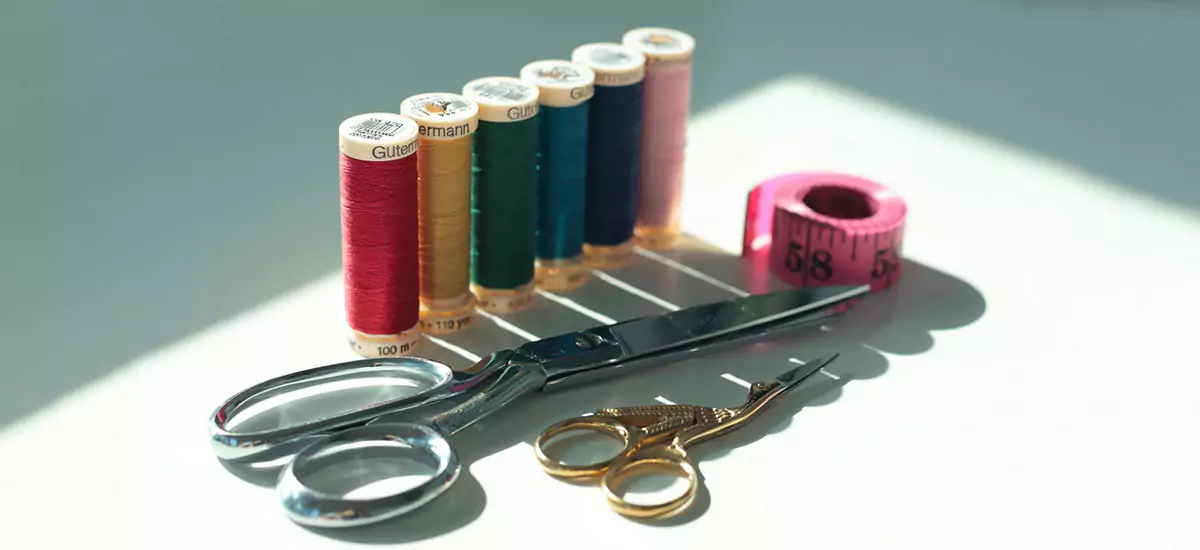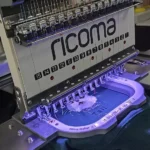Embroidery is an immortal fine art that has enhanced textures for quite a long time, changing basic materials into complicated show-stoppers. With various needles accessible, choosing the right one for various ventures can plague. This guide will assist you with exploring the different kinds of embroidery needles and their particular purposes, guaranteeing your activities end up being delightful.
Before digging into the points of interest, it’s fundamental to comprehend the life systems of an embroidery needle and the elements that separate them: (Eye) The string passes through the opening. Embroidery needles mostly have bigger eyes than standard sewing needles to oblige thicker strings or various strands. (Point) The tip of the needle penetrates the texture. It tends to be sharp or obtuse, contingent upon the sort of texture and fasten. (Shaft) The long, flimsy piece of the needle that goes through the texture. The thickness of the shaft influences the size of the opening made in the texture.
Types Of Embroidery Needles
1. Crewel needles
They have a sharp point and a medium-sized eye, making them reasonable for most textures and embroidery threads. Best for: Fleece strings, standard embroidery floss, silk, and cotton.
Ideal projects: General embroidery, including surface embroidery and crewel work.
2.Tapestry needles
Tapestry needles have an unpolished point and a huge eye. The unpolished tip permits the needle to pass between the strings of the texture without dividing them, making it ideal for counted string weaving on even-weave textures. Best for Perle cotton, yarn, and thicker strings.
Ideal projects: Cross-join, needlepoint, and blackwork.
3. Chenille needles
They are like crewel needles yet with a bigger eye and a thicker shaft. They have a sharp point, making them reasonable for heavier textures and strings. Best for Fleece, strip, and other weighty strings. Ideal projects: Lace embroidery, crewel work, and working with thicker strings on durable textures.
4. Embroidery needles
Frequently alluded to as frivolity needles, are better than crewel needles and have a bigger eye compared with their size. This makes them reasonable for definite work with fragile strings. Best for: Fine embroidery strings, metallic strings, and silk. Ideal projects: Detailed and delicate embroidery, beadwork, and embellishments.
5. Milliner’s needles
They have a long shaft and a little, round eye. They are uniform in thickness from the eye directly, making them ideal for bullion hitches and other wrapped fastens. Best for: Bullion hitches, French bunches, and cast-on lines. Ideal projects: Stumpwork, Brazilian embroidery, and other layered weaving procedures.
6. Beading needles
Beading needles are incredibly fine and adaptable with a little eye. They are intended to go through the little openings of globules without breaking. Best for: Seed dabs, cornet dots, and other little globules.
Ideal projects: Bead embroidery, jewelry making, and embellishing textiles with beads.
Choosing The Right Needle For Your Project
Choosing the fitting embroidery needle for your undertaking includes thinking about the texture, string, and kind of fastening you’ll utilize. Here are a few hints to assist you with settling on the ideal decision:
1. Consider the Fabric
The texture’s weight and weave play a huge part in needle determination. For instance:
Lightweight textures: Utilize better needles, for example, weaving or milliner needles to try not to harm the texture.
Heavyweight textures: Settle on chenille or embroidered artwork needles that can deal with thicker strings and the texture’s weight.
Indeed weave textures: Embroidery needles are ideal as they coast between the texture strings without dividing them.
2. Match the Thread
The thickness and kind of string additionally impact needle decision:
Meager strings: Better needles like embroidery or beading needles work best to forestall extending the texture openings.
Thick strings: Use chenille or embroidery needles with bigger eyes to oblige the string.
Specialty strings: Metallic or silk strings require needles with bigger eyes to decrease grating and forestall frayings, for example, crewel or embroidery needles.
3. Type of Stitch
Surface embroidery: Crewel needles are adaptable and function admirably for most surface lines.
Counted string embroidery: Woven artwork needles are ideal for cross-fasten and other counted methods.
Layered embroidery: Milliner needles are great for making hitches and wrapped lines.
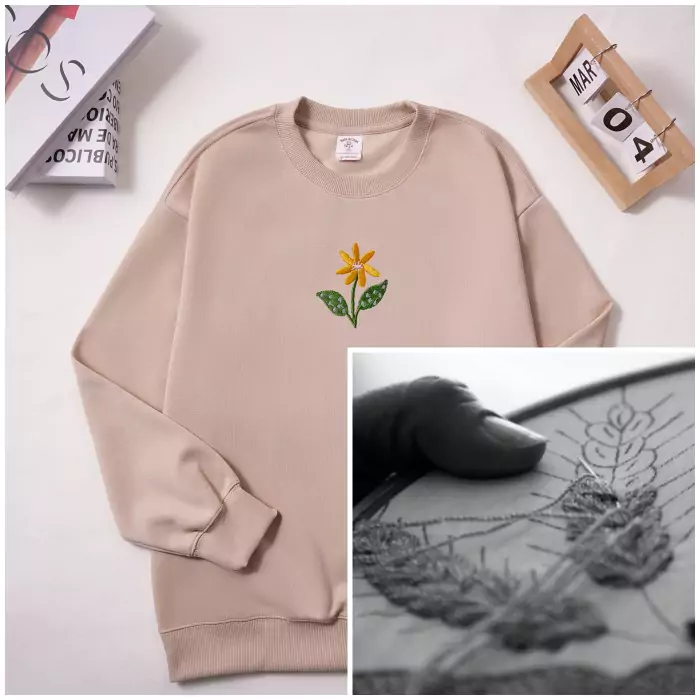
Embroidery Needle Size Chart
1. Crewel Needles
- Size 1-5: Utilized for weighty embroidery work on thicker textures. Reasonable for fleece or weighty strings.
- Size 6-10: Normal sizes for general embroidery work on medium-weight textures.
- Size 11-12: Ideal for fine embroidery work on lightweight textures. Reasonable for sensitive strings like silk.
2. Embroidery Needles
- Size 13-14: For coarse textures and material work. Reasonable for yarn or various strands of embroidery floss.
- Size 16-18: Usually utilized for cross-sewing on Aida material or even-weave textures.
- Size 20-26: For better textures and itemized work. Appropriate for fine strings or single strands of embroidery floss.
3. Chenille Needles
- Size 13-14: For weighty textures and thick strings. They are frequently utilized in crewel embroidery.
- Size 16-18: Adaptable sizes for medium to weighty textures.
- Size 20-24: For better textures and itemized chenille work.
4. Milliner Needles
- Size 1-3: For weighty embroidery work and cap making.
- Size 5-7: Normal sizes for general embroidery and beautiful fastens.
- Size 9-12: Ideal for fragile work and fine textures. Appropriate for bullion hitches and comparable join.
5. Beading Needles
- Size 10-13: For hanging little dabs and fine beading work. Appropriate for lightweight textures.
- Size 15: Exceptionally fine needle for mind-boggling beading plans and sensitive textures.
Do You Know DMC Embroidery Needle Size Chart
DMC, a notable brand in the embroidery scene, offers a scope of embroidery needles in different sizes to suit different sewing needs. Here are the normal needle sizes accessible from DMC:
- Size 1: This is the biggest size presented by DMC and is appropriate for heavier textures or yarns. Ideal for projects that require thicker strings or brightening sewing on thick materials.
- Size 3: A somewhat more modest needle size contrasted with size 1, size 3 needles are as yet reasonable for heavier textures and strings. They give flexibility to the scope of embroidery methods and undertakings.
- Size 5: Size 5 needles are medium-sized and generally utilized for standard embroidery projects on different texture types. They offer a harmony between strength and accuracy, making them reasonable for most embroidery undertakings.
- Size 7: Considered a fine needle size, size 7 needles are reasonable for fragile textures and mind-boggling sewing. They function admirably with better strings and are ideal for point-by-point embroidery work.
- Size 9: The smallest size presented by DMC, size 9 needles are super fine and ideal for dealing with lightweight textures and complicated plans. They take into consideration exact sewing and fragile itemizing.
Each size of DMC embroidery needles fills a particular need and offers extraordinary advantages relying upon the task’s necessities. By choosing the fitting needle size, you can guarantee smooth and precise sewing in your embroidery projects.
Practical Tips For Using Embroidery Needles
How To Knot An Embroidery Needle
To start with, string your weaving needle. Cut a length of weaving floss, ordinarily around 18 inches. Separate the strands if necessary, involving a few strands for most ventures. Embed the string through the needle’s eye, utilizing a needle threader if fundamental. Make a Bunch toward the Finish of the String. To begin sewing, you want to protect the string with a bunch. The following are two normal techniques for making a bunch.
- Hold the finish of the string between your thumb and index finger.
- Make a circle close to the furthest limit of the string by folding it over your finger.
- Pass the finish of the string through the circle.
- Pull the string to fix the circle into a bunch toward the end.
Make one more overhand bunch at a similar spot by rehashing the means. Pull the second bunch cozily against the principal tie. This twofold bunch adds additional security, particularly for thicker textures. Push the needle through the rear of the texture to carry the string to the front. The bunch will moor the string, keeping it from getting through the texture.
At the point when you complete your sewing, you’ll have to get the string on the rear of the texture. Slide the Needle Under Fastens: Pass the needle under a couple of joints on the rear of the texture to moor the string. Hitching may take a couple of attempts to consummate. Work on making bunches to guarantee they are secure and flawless.
Punch Embroidery Needle For Beginners
- Push the threader through the needle’s empty shaft from the highlight of the handle.
- Spot the string in the threader circle and get it back through the needle.
- Supplement the threader through the needle’s eye, place the string in the know, and get it through.
- Place your texture firmly in an embroidery circle. Guarantee making even and reliable loops is tight.
- Hold the needle like a pen, with the slant looking up.
- Drive the needle into the texture until the handle contacts the surface.
- Haul the needle out somewhat, barely enough to move to the following spot.
- Keep punching in an orderly fashion or example, keep the needle at a predictable level to frame even circles.
- Slice the string near the texture on the two sides.
- Delicately press the circles with your fingers to get them.
How To Thread Embroidery Needle 3 Strands
Ensure the strands stay adjusted and together all through the stringing system to forestall tangling. If you find it trying to string the needle with three strands, think about utilizing a needle threader to assist with directing the string through the opening of the needle. Stringing with various strands might require a touch more persistence and artfulness. Take as much time as necessary and try not to rush the cycle to accomplish a perfect and secure stringing.
How To Tie An Embroidery Needle
Tying a needle bunch might take a couple of attempts to dominate, so don’t get deterred on the off chance that it’s flawed the first time. Continue to practice, and you’ll improve with time. Try not to utilize unreasonably lengthy or short lengths of string, as they can make securing the bunch seriously testing and lead to tangles. Pull the bunch sufficiently tight to tie down the string to the needle yet not excessively close to harm the string or needle. Tying an embroidery needle is an essential expertise in embroidery that guarantees smooth and continuous sewing. By adhering to these step-by-step directions and tips, you can tie your embroidery needle safely and with certainty start your sewing project.
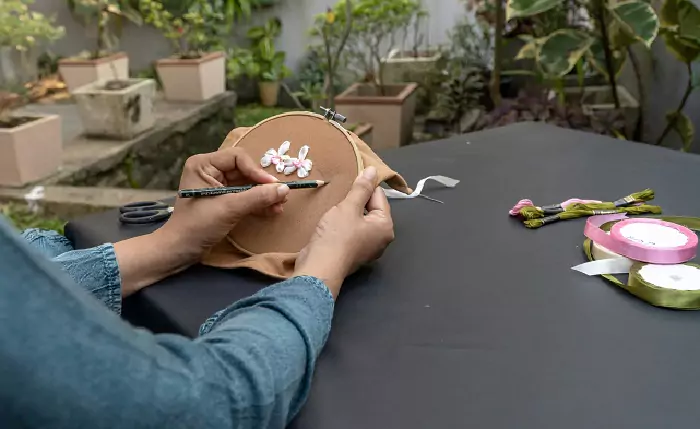
Advanced Techniques And Specialty Needles
Investigating progressed procedures and specialty needles can open up new innovative potential outcomes for those hoping to extend their embroidery collection.
How Does An Embroidery Pen Work
The embroidery needle pen is a helpful device intended to hold and administer embroidery needles advantageously. A pen-like gadget makes stringing needles simpler and more productive, particularly for individuals who experience issues stringing needles the hard way.
Embroidery needle pen commonly looks like a standard pen in size and shape. It comprises an empty barrel that holds numerous embroidery needles safely inside. The barrel of the pen is intended to oblige a few needles of various sizes, permitting you to have a determination of needles promptly accessible for different embroidery projects. The highest point of the pen normally has an instrument for apportioning needles each in turn. By turning or tapping the pen’s top, you can broaden a solitary needle from the barrel, making it effectively open for stringing.
Some embroidery needle pens accompany a coordinated needle threader appended to the top. This component further works on the needle stringing process, particularly for people with expertise issues or visual debilitations. The conservative and lightweight plan of an embroidery needle pen makes it versatile and helpful for conveying in your embroidery unit or sewing sack. It’s ideally suited for movement or taking to embroidery classes and studios.
Utilizing an embroidery needle pen is direct. Essentially wind or snap the highest point of the pen to expand a needle, string it with your ideal embroidery floss, and begin sewing. The apportioning system guarantees that each needle remains safely put away when not being used. Embroidery needle pens are viable with different kinds and sizes of embroidery needles, permitting you to tweak your needle determination given your undertaking prerequisites. Whether you’re working with fine textures or thick materials, an embroidery needle pen gives you the adaptability you want.
Clover Embroidery Needle Threader
The clover embroidery needle Threader is a helpful device intended to help with stringing embroidery needles rapidly and without any problem. It includes a minimized and lightweight plan, making it simple to convey in your embroidery pack or sewing sack. This needle threader fills a double need, permitting you to string both embroidery needles and sewing machine needles effortlessly.
To utilize the clover embroidery needle threader, essentially embed the needle into the assigned space on the threader. Then, at that point, embed the string through the little snare or wire circle given, and tenderly force the threader away from the needle. The string will be gotten through a clover embroidery needle Threader is viable with an extensive variety of embroidery needle sizes, from fine to substantial, making it reasonable for different embroidery undertakings and string types.
Built from strong materials, the clover embroidery needle Threader is intended to endure successive use without twisting or breaking. Even amateurs can undoubtedly excel at stringing needles with the clover embroidery needle Threader. Its basic and instinctive plan makes stringing needles a breeze, saving you time and dissatisfaction. notwithstanding embroidery needles, the clover embroidery needle Threader can likewise be utilized to string sewing machine needles, making it an adaptable device for all your embroidery needs. The clover embroidery needle Threader is a reasonable and practical device that can save you important time and exertion while dealing with embroidery projects.
Tambour Embroidery Needle Guide
Tambour embroidery needle is a particular device utilized in tambour. embroidery, a method that includes making chain join or other enhancing lines with a snared needle. This is the thing you want to be familiar with tambour embroidery needles:
Snared Plan: Tambour embroidery needles have a little snare or lock at the tip rather than a conventional sewing needle’s eye. This snare permits the needle to catch and get the string through the texture, making a persistent line of fastens.
Assortment of Sizes: Tambour needles come in different sizes to oblige different string thicknesses and texture types. The size of the needle decides the size of the joint and the general appearance of the embroidery.
Utilization: Tambour embroidery is normally finished on a firmly extended texture, for example, a texture held in an embroidery circle or an exceptional tambour embroidery outline. The needle is embedded from the rear of the texture, and the snare is utilized to get the string and get it through to the front, making fasten as the needle is moved along the texture.
Flexibility: Tambour embroidery needles can be utilized to make a great many enlivening join, including chain lines, feather fasten, and even beadwork. The procedure is frequently used to adorn dresses, frills, and home-style things.
Ability Required: Tambour embroidery requires training and expertise to dominate, especially in controlling the pressure of the joint and keeping an even line length. Notwithstanding, with tolerance and persistence, it tends to be a fulfilling and pleasant embroidery procedure.
Accessibility: Tambour embroidery needles are accessible from specialty embroidery shops and online retailers that take care of embroidery fans. They may likewise be remembered for tambour embroidery units alongside guidelines and other vital materials.
Crewel Embroidery Needle Work
- Customarily utilized for crewel work, which includes fleece strings on cloth or comparable textures. The sharp tip and enormous eye handle are the thicker strings utilized in this style of embroidery.
- Reasonable for an assortment of surface embroidery methods, including silk fastens, stem lines, and French bunches. The sharp tip takes into consideration the exact arrangement of lines.
- Ideal for embroidery projects utilizing thicker strings like pearl cotton or various strands of standard embroidery floss.
Select a needle size that matches your string and texture. For thicker strings, utilize a bigger needle (sizes 1-5). For better strings, pick a more modest needle (sizes 6-10). Cut a length of endlessly string it through the opening of the needle. The medium-long eye makes this cycle simpler, particularly with thicker strings.
A Guide to Ballpoint Embroidery Needle
A ballpoint embroidery needle is a specific device utilized in embroidery, especially for sewing on or extending textures. This is the thing you want to be familiar with ballpoint embroidery needles:
Dissimilar to standard embroidery needles with sharp places, ballpoint embroidery needles have an adjusted tip with a somewhat adjusted or ball-formed point. This plan permits the needle to slip between the filaments of weave or stretch textures without harming or catching them. Ballpoint embroidery needles are explicitly intended for use on stretchy textures like shirts, spandex, knitwear, and other sew textures. The adjusted tip keeps the needle from puncturing or breaking the filaments, bringing about smooth and even join. While ballpoint embroidery needles are utilized for sewing on stretch textures, they can likewise be utilized for standard embroidery projects on woven textures. In any case, they may not be essentially as viable as sharp-point needles for thick or firmly woven materials.
When utilized accurately, ballpoint embroidery needles produce great join with negligible twisting or puckering on stretch textures. They assist with keeping up with the texture’s stretchiness and versatility, guaranteeing the completed embroidery holds its shape and solace.
Ballpoint embroidery needles are accessible in different sizes, going from fine to uncompromising, to oblige different texture thicknesses and string loads. Picking the right needle size guarantees ideal sewing results and forestalls texture harm. While sewing with a ballpoint embroidery needle, utilize a stabilizer or circle to help the texture and forestall extending. Begin with a test line on a piece of texture to decide the needle size and string pressure required for your particular venture.
What Is A 75/11 Needle Used For
Embroidery devotees know the significance of the right apparatuses. Among these, the 75/11 embroidery needle stands apart for its adaptability and accuracy. 75/11 embroidery needle is a medium-sized needle, ideal for most embroidery undertakings. The number 75 alludes to the European measurement size, while 11 is the American size. This size is great for point-by-point and complicated embroidery work.
One of the essential advantages of the 75/11 embroidery needle is its adaptability. It functions admirably with different textures, from lightweight cotton to medium-weight materials. This versatility makes it a favorite among embroiderers. Accuracy is significant in embroidery, and the 75/11 needle succeeds in this viewpoint. Its fine point guarantees perfect and exact fastens, improving the general nature of the embroidery. This accuracy makes it ideal for point-by-point plans.
Toughness is another critical benefit. The 75/11 embroidery needle intends to endure broad use. Its hearty development guarantees that it remains sharp and viable, even after delayed use.
This needle functions admirably with lightweight textures like cotton, cloth, and silk. Its fine point infiltrates these materials easily, guaranteeing smooth and exact fastens. Medium-weight textures, including denim and material, are additionally appropriate for the 75/11 needle. Its solidarity and sharpness permit it to deal with these harder materials without compromising fasten quality.
75/11 Ballpoint Needle Are Also Important
A 75/11 ballpoint embroidery needle is a particular instrument utilized for embroidery sewing and extending textures. The measurement size is 75, and the comparing Vocalist size is 11. This size is great for medium-weight textures. Ballpoint tip is adjusted as opposed to sharp. This plan permits the needle to skim between the texture filaments without cutting them, which is fundamental for forestalling obstacles and runs in sewing and extending textures. Ideal for stretch materials like spandex, lycra, and other flexible textures. The needle obliges the texture’s adaptability and stretch.
The ballpoint configuration helps in smooth and predictable sewing, particularly significant in machine embroidery. Use an embroidery string that supplements the texture type. Polyester or rayon strings function admirably with ballpoint needles. Guarantee the needle is accurately introduced in your embroidery machine. Embed the needle with the level side confronting the rear of the machine. Contingent upon your texture and string, you might have to change the strain settings on your embroidery machine for ideal outcomes. Consistently do a test line on a piece of texture to guarantee that the needle, string, and machine settings are cooperating impeccably.
Can I Use A 90 14 Needle For Embroidery
This needle size is appropriate for significant burden textures like denim, material, upholstery textures, and other thick materials. It gives the important strength and solidness to infiltrate these thick textures without bowing or breaking. The 90/14 embroidery needle can oblige an assortment of string types, including embroidery floss, pearl cotton, and specialty strings like metallic or topstitching strings. It has a bigger eye and a more grounded shaft to deal with thicker strings easily.
While utilizing the 90/14 embroidery needle, you can expect top-notch sewing results, even on extreme textures. The needle’s sharp point and strong development guarantee smooth and exact sewing, permitting you to make mind-boggling plans easily. While fundamentally utilized for embroidery on weighty textures, the 90/14 needle can likewise be appropriate for other sewing errands like improving sewing, topstitching, and knitting on thick materials. Think about utilizing the 90/14 embroidery needle for projects like decorating denim coats, making woven patches, sewing plans on material handbags, or stitching through numerous layers of texture.
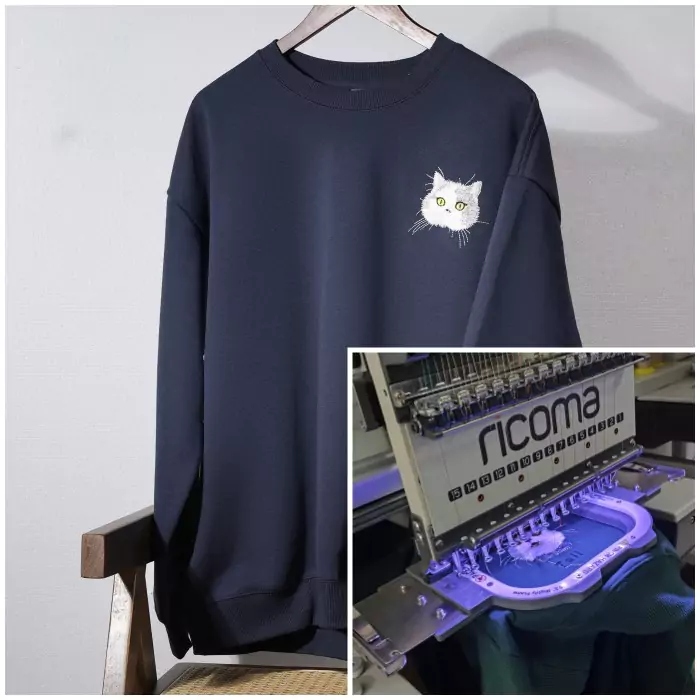
Sewing Needle VS Embroidery Needle
Sewing needles and embroidery needles are fundamental devices in the realm of embroidery, each intended for explicit assignments. Understanding their disparities and utilizations can assist you with picking the right needle for your undertaking.
Sewing Needles
Sewing needles have a sharp, pointed tip intended to puncture through firmly woven textures. The eye of a sewing needle is little, sufficiently large to oblige standard sewing strings.
General Needles: Flexible and can be utilized on different textures, both woven and woven.
Sharps Needles: Have a fine point and are great for definite sewing on lightweight textures.
Stitching Needles: Explicitly intended for knitting, they have a tightened point that decreases erosion and takes into consideration more straightforward development through thick layers.
Ballpoint Needles: Have an adjusted tip and are utilized for sewing on weave and stretch textures without harming them.
Ideal for ordinary sewing undertakings, like pieces of clothing development, stitching, and adjustments. Appropriate for fine and itemized sewing on different textures. Successful for piecing and knitting layers of texture and batting.
Embroidery Needles
Contingent upon the sort, embroidery needles can have a sharp or obtuse tip. Sharp tips are utilized for general embroidery, while obtuse tips are utilized for counted string work on even-weave textures.
Huge Eye: The eye of an embroidery needle is bigger to oblige numerous strands of embroidery floss or thicker strings.
Crewel Needles: Have a sharp tip and a medium-long eye, reasonable for most surface embroidery procedures.
Embroidery Needles: Element a dull tip and an enormous eye, ideal for counted string weaving, like cross-line and needlepoint.
Chenille Needles: Have a sharp tip and an enormous eye, ideal for crewel work and embroidery with thick strings or strips.
Milliners Needles: Otherwise called straw needles, they are long with a little round eye, ideal for making hitches and wrapped join.
Surface Embroidery: Ideal for making embellishing fastens on the texture’s surface, for example, silk join, chain line, and French bunches.
Counted String Work: Woven artwork needles are utilized for counted string methods where the needle goes through pre-made openings in the texture.
Textural Embroidery: Chenille needles are utilized for adding surfaces with thicker strings or strip embroidery.
Embroidery Needles Near To Me
Stores like Michaels, Joann Textures, and Side Interest Hall frequently convey a wide assortment of embroidery needles and other weaving supplies. Take a look at their sites for store areas and stock accessibility. Nearby, autonomously claimed to create stores are likewise liable to convey embroidery supplies. These stores might offer a more customized shopping experience and novel items. Stores gaining practical experience in textures, for example, quilt shops or sewing supply stores, regularly have a part committed to embroidery devices and embellishments.
Numerous Walmart areas have an art segment that incorporates embroidery supplies. Some Objective stores might convey fundamental embroidery supplies in their art area. These specialty stores center only around the embroidery and are an incredible spot to track down a wide determination of needles and master exhortation. Sites like Amazon, Michaels, and Joann permit you to check neighborhood store stock on the web and deal choices for in-store pickup. Use Google to look for “embroidery needles near to me” to find neighborhood stores that convey embroidery supplies. Check Cry for client surveys and appraisals of nearby specialty and texture stores. The Business index can likewise be a helpful asset for finding nearby sewing and art stores.
Before visiting a store, look at their site or call ahead to guarantee they have embroidery needles in stock. Assuming you’re new to embroidery, ask the store staff for proposals on needle sizes and types for your particular ventures. A few stores offer packs that incorporate an assortment of needle sizes and types, which can be valuable for various embroidery strategies.
Conclusion
Choosing the right embroidery needle size is fundamental for accomplishing proficient and smooth outcomes in your undertakings. By understanding the connection between needle size, texture, and string, you can guarantee your embroidery is both lovely and tough. Happy stitching!
FAQ’s
1. How To Set Up An Embroidery Needle
Stringing the needle might take some training, particularly for novices. Take as much time as necessary and show restraint. Pick the right needle size and type for your texture and string to guarantee smooth sewing. Keep the texture tight and keep up with even pressure on the string to accomplish predictable lines. Go ahead and explore different avenues regarding different line types and procedures to improve your embroidery abilities.
2. Can You Bring An Embroidery Needle On A Plane
Indeed, you can normally bring an embroidery needle on a plane in your lightweight gear or individual thing. Embroidery needles are for the most part permitted in both homegrown and global flights, as they are viewed as protected and harmless things. Be that as it may, it’s fundamental to follow a few insurances to guarantee a smooth travel insight. Spot your embroidery needles in a protected compartment, for example, a needle case or a little travel sewing unit, to keep them from unintentionally jabbing through your sack.
On the off chance that security staff need to examine your lightweight baggage, be ready to show them your embroidery needles and make sense of their motivation. Having them stuffed perfectly and noticeably can assist with facilitating the security screening process. On the off chance that you habitually travel with sewing or creating supplies, you might consider applying for TSA PreCheck or a comparable facilitated screening program. This can smooth out the security interaction and lessen the probability of any issues with bringing your embroidery needles ready.
3. Why Does My Embroidery Needle Keep Breaking
On the off chance that your embroidery needle continues breaking, a few elements could be adding to the issue. Here are a few normal justifications for why embroidery needles break and how to address them:
Wrong Needle Size
Utilizing some unacceptable needle size for your texture or string can make the needle break. Ensure you’re utilizing a needle size proper for the texture thickness and string weight you’re working with.
Texture Sticking
On the off chance that the texture is excessively firmly hooped or on the other hand assuming there are different layers of texture, it can come down on the needle, making it break. Take a stab at releasing the loop pressure or decreasing the number of texture layers to lighten the weight on the needle.
Dull Needle
A dull or broken down needle is bound to break than a sharp one. Supplant your needle routinely, particularly assuming you notice it catching or skipping lines.
Inaccurate Needle Type
Involving some unacceptable kind of needle for your embroidery procedure or texture can prompt breakage. For instance, utilizing a sharp needle on a stretchy weave texture can make it break. Ensure you’re utilizing the suitable needle type for your task.
Thread Pressure
The inordinate strain on the string can make the needle curve or break as it attempts to enter the texture. Take a look at your machine’s pressure settings and change them depending on the situation to accomplish adjusted strain.
Machine Glitch
On the off chance that your embroidery machine isn’t as expected aligned or on the other hand if there’s a mechanical issue, it can put excessive weight on the needle and prompt it to break. Look at your machine for any indications of glitches and use the producer’s manual for investigating tips.
Needle Deformity
In uncommon cases, an imperfect needle might be the offender. Review your needles for any apparent deformities, like twists or burrs, and supplant them if important.
Inaccurate Needle Establishment
Inappropriately embedding the needle into the machine or neglecting to fix it safely can make it break during sewing. Ensure the machine’s guidelines accurately embed and fix the needle.
For more Embroidery and Gift related content, we invite you to explore the diverse range of articles available on mystichot blog. Discover a wealth of resources that will fuel your passion and help you unlock your creative potential.

